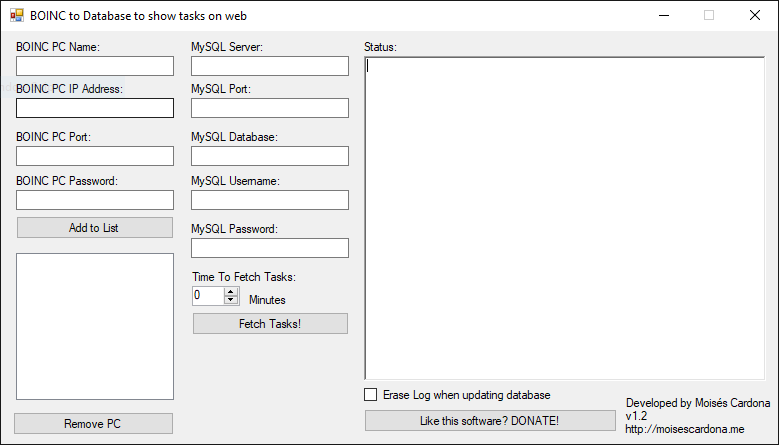
I thought of this as the sound of a drop of water falling into a pool. I played around with various acronyms and settled on "BOINC" -īerkeley Open Infrastructure for Network Computing. I wanted a less imposing name - something light, catchy,Īnd maybe - like "Unix" - a little risqué. Often taken from Greek mythology - Hydra, Medusa, and so on.
#BOINC HOST LOCATION SOFTWARE#
This later caused friction with several companies who wanted to use BOINC,īut mostly because their lawyers didn't know the differenceīetween LGPL and GPL (which are very different).Īcademic software projects tend to adopt ponderous names,
#BOINC HOST LOCATION CODE#
The code would be open source, distributed under the LGPL license.Would be owned by the University of California. All BOINC code - by me and by outside volunteers.I didn't aspire to do a startup and get rich from BOINC. I contacted the UC lawyers, and they arranged a meeting with UD,Īt which I pointed out that the UD claims were bogusĪnd in fact UD was using ideas developed at UCB for lawsuit was quickly withdrawn. In March 2002 United Devices filed a lawsuit against me,Ĭlaiming that I had stolen their trade secretsĪnd demanding that I stop working on BOINC.Ī policeman came up to Space Sciences LabĪnd dropped a thick stack of papers on my desk.īut when I looked at the list of supposed "trade secrets",Įxample: "an interface to shared memory that involves create, attach, detach, and destroy operations" I wrote the client and server in C++ and the web code in PHP. Mostly working in a cafe called The Beanery in Berkeley In a few months in late 2001 and early 2002, on a Linux laptop, I wrote the central part of BOINC - client, server, Web code. This time open source, with no profit motive. So in 2001 I quit UD, and started working on BOINC -Īnother volunteer computing infrastructure, UD hired some people who didn't like my approach My colleagues were (justifiably) skeptical about this,Ĭommuting between Berkeley and Austin TX,Īnd I developed an infrastructure for them.

They wanted to hire me as CTO, and I needed a job. That wanted to develop such an infrastructure and monetize it. In 2000 I was approached by a startup company, United Devices (UD), I starting thinking about creating a general-purpose infrastructure On infrastructure issues (notably DB and server sysadmin) This meant separating the infrastructure from the science,Īlso, we found ourselves spending too much time We needed to be able to change the science code frequently,
#BOINC HOST LOCATION INSTALL#
The infrastructure part (network communication,įetching and returning jobs, working invisibly in the background)Īnd the science part (the data analysis).Īll the volunteers had to download and install a new version of the program. Initially, was a single program, which included both Over 1000 years of computer time per day - mind-boggling. In 1998 we got the whole thing working, and we launched in May 1999.įor about a year we got tons of mass-media publicity,Īnd the number of volunteers soared to over a million. Two years eventually got some funding and we hired a few programmers.Įric Korpela joined and wrote the science code. We talked of forming an organization called "Big Science" that would coordinate volunteer computing,Īnd we briefly owned the domain ''. Physics, Earth Science, biomedicine, and so on. Looking for "technosignatures": synthetic signals coming from space.ĭan, Woody, me, Dave Gedye at 10th anniversary in 2009īut from the beginning, Gedye and I thought of volunteer computingĪs being of potential use in all areas of science. Together with Woody Sullivan and Dan Werthimer we the goal of using volunteer computing to analyze radio telescope data, Gedye conceived of the idea of volunteer computing, We became running partners, and have been fast friends (ha ha) ever since. He was a Teaching Assistant in my Operating Systems class. from 1985 to 1992.ĭavid Gedye was a graduate student there. If there's an omission or factual error, please let me know.ĭavid Gedye and taught in the UC Berkeley Computer Science Dept. This essay documents the history of BOINC from my perspective.Īnd offers some theories about why things happened as they did.īut mostly about people: personalities, aspirations, and conflicts. Is an important chapter in the history of science. Hence I think that volunteer computing - and BOINC in particular. To involve the worldwide public directly in science, It has been used by about 50 projects in many areas of science,Ĭomputing has emerged as a central tool in every area of science.īOINC sought to expand this tool by orders of magnitude,

Their home computers and smartphones to science research projects.

Is a software system for "volunteer computing": Thanks to Mike McLennan and others for edits.


 0 kommentar(er)
0 kommentar(er)
